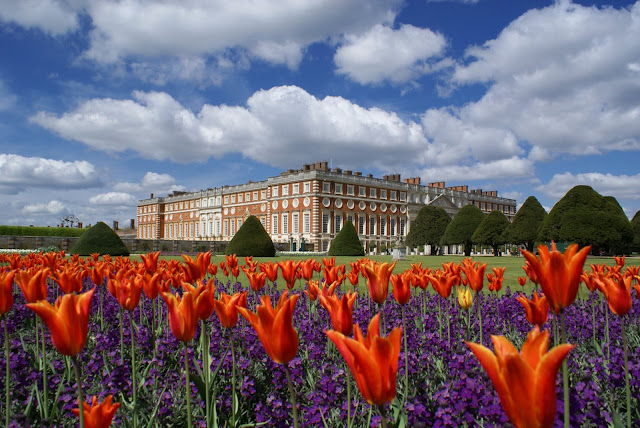Hampton Court Palace, today the oldest remaining Tudor palace in England, boasts of its internationally-renowned gardens that span 60 acres of formal gardens and 750 acres (304 hectares) of parkland that lie within a loop of the River Thames. Garden history tours are offered to guests, which cover over 500 years of history. The gardens are home to the world's oldest puzzle maze, the record-breaking grape vine, three National Plant Collections and a huge variety of wildlife, including the descendants of Henry VIII’s deer herd. There's really so much to see in this historic palace!
When springtime comes, the gardens bloom with the spectacular herbaceous border in the East Front Gardens at its best. Queen Mary II's Exoticks bud in profusion at the Lower Orangery Garden. Towards the end of summer, the Great Vine grapes are harvested and with the coming of autumn, the Tiltyard, Wilderness and 20th Century Garden burst with hues of red and orange. Winter sees the trees of Home Park and the topiary of the Privy Garden filled with white blankets of snow. More than one million flowering bulbs in the Wilderness come to life in spring resulting to a riot of colour that brings excitement to guests in the formal gardens.
The Great Fountain Garden is where visitors could simply relax in the shade of the centuries-old yew trees while splurging on the breathtaking view of the glistening fountain. Tired of the rich history lessons offered by the tour? Unwind as you stroll along the Broad Walk. At 580 metres it is the longest herbaceous mixed flower border in Britain.
The Privy Garden was originally designed to provide the Sovereign with security and privacy away from the affairs of State and the first Privy Garden at Hampton Court Palace was laid out between 1530 and 1538 for King Henry VIII.
The Privy Garden is a re-creation of William III's Privy Garden and inspired by the original 17th century design and historic planting lists. The well-laid symmetrical pattern adopts the original varieties of plants while highlighting the magnificent marble sculptures.
Originally designed to be King William III's private greenhouse. Orange trees and bay trees were kept at the Orangery in the winter months and they would then be moved outside onto the terrace which lead to the Privy Gardens. Today, the Orangery is a favorite venue for elegant drinks receptions and glorious gatherings
The Hampton Court Palace Maze is the oldest surviving hedge maze in the entire United Kingdom. William III commissioned George London and Henry Wise to convert a third of an acre into a trapezoidal maze to confuse and intrigue visitors with its many twists, turns and dead ends.
The Pond Gardens are the legacy of Henry VIII. They teem with color and life during spring and summer when the tulips are in full bloom. Queen Mary II turned the Tudor pond yards into sunken gardens where she planted her exotic floras. The picture above shows the West Pond Garden.
Canals surround the palace, too, adding beauty to the landscape.
Here's another well-tended garden blooming in summertime. The Banqueting House as seen from outside the private garden.
The palace's Tudor legacy is evident even in the gardens. The Knot Garden, for example, is a Tudor design adjacent to the Tudor section.
Enjoy more lovely photos of the gardens below. Find out more details of Hampton Court Palace here.






















.png)





1 Comments
I love this
ReplyDelete